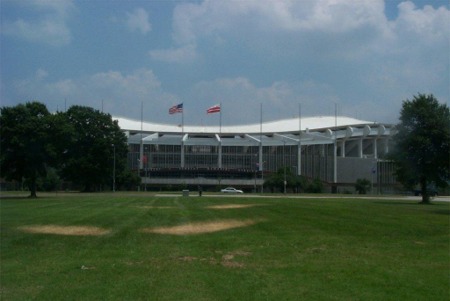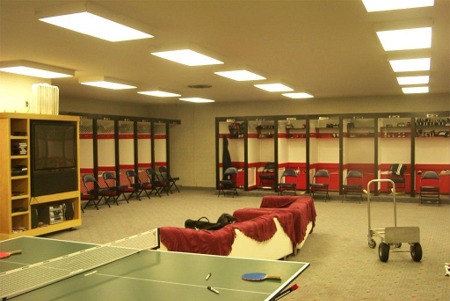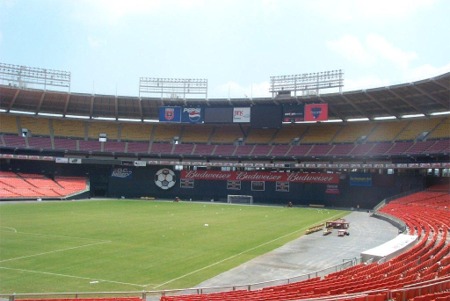RFK Stadium
Washington, DC
By
Ken Schlapp
I got up early to
make my way up North to see the home of the Senators. It is about a
4-hour drive to DC from Roanoke, which in the whole scheme of things
was a short drive for me on this long journey. The second coming of
the Senators played their home games at Robert F Kennedy Memorial
Stadium (RFK) in Washington, DC from 1962 to 1971, prior to moving
to Texas and becoming the Texas Rangers. I always thought the
history of the Senators was so interesting and strange. The
original Senators were famous for the vaudeville joke “First in War,
First in Peace, last in the American League!” Although, that was
from when they played their games at Griffith Stadium (demolished in
1965).
 The
strange twist was that they left Washington after the 1960 season to
move to Minnesota becoming the Twins in 1961. However, they were
immediately replaced by the expansion Washington Senators the
following season. So the Minnesota Twins and the Texas Rangers were
both originally the Washington Senators. The
strange twist was that they left Washington after the 1960 season to
move to Minnesota becoming the Twins in 1961. However, they were
immediately replaced by the expansion Washington Senators the
following season. So the Minnesota Twins and the Texas Rangers were
both originally the Washington Senators.
The new Senators
played their first season at Griffith Stadium in 1961. They did not
move into RFK Stadium, which was originally called the District of
Columbia Stadium, until 1962 (the stadium name was not changed until
1969). The stadium had opened in the prior year for the NFL’s
Washington Redskins, who played at RFK through the 1996 season.
Since the Senators left after the 1971 season and the Skins after
1996, the stadium has been predominantly the home of the DC United
of MLS soccer league. This all means that I will not be able to see
a baseball game here, but it does not mean I will not get to see the
stadium. I was able to contact Troy Scott of DC Sports and
Entertainment to show me around RFK.
I started off with
my traditional walk around the outside and noticed that the roof
somewhat reminded me of Hiram Bithorn Stadium with the wavy look
that almost looks concave. The other things that stood out were the
two statues outside. One statue was for Clark Calvin Griffith, who
was a player, manager, and eventual owner of the Senators. The
other statue was of George Preston Hall, the founder of the
Redskins. I like the way they celebrate and honor the history of
the teams that played there. Once inside, you see more of the
respect for history with the banners of player’s names along the
upper deck rim. Included are baseball players like Frank Howard,
football players like Sonny Jurgensen, and owners like Clark
Griffith. Some of the other historic perks had to do with the few
white seats, recognizing monumental home runs hit by Frank Howard.
What stands out about them is how they are situated in between all
the bright orange, yellow, and red seats, which are not unlike the
Astrodome.
The fun part for me
was the personalized tour provided by Troy. We walked all over the
stadium from the concourses to the field to the seats and through
the locker rooms and to other places you would not ordinarily have
access. When we were in the basement corridors, Troy found some of
the old Cracker Jack Baseball programs and baseballs to give me. He
talked about how they
 played
that old-timer game at RFK in 1983, which was famous for the
75-year-old Luke Appling hitting a home run (I remember watching
that on TV too!). He also spoke of how there were not too many
other baseball games played at RFK after that game. In fact, the
last game played at RFK was a spring training game between the Expos
and Cardinals in 1999. played
that old-timer game at RFK in 1983, which was famous for the
75-year-old Luke Appling hitting a home run (I remember watching
that on TV too!). He also spoke of how there were not too many
other baseball games played at RFK after that game. In fact, the
last game played at RFK was a spring training game between the Expos
and Cardinals in 1999.
He talked about how
the stadium was designed with a complex conversion system to move
some portions of the seats to accommodate football and then back to
baseball. I also read that the bleacher section is less stable than
other seating, which allowed fans to jump and cause the whole
section to shake and rumble. The most interesting thing that he
discussed was that he did not think that system would work anymore
to convert back to baseball. As we walked on the field, it was set
up for soccer, since that is the main sport played here. The
amusing thing at this point a few years after that day is that they
did figure out a way to make it baseball-friendly again when the
Expos moved to RFK in 2005, while becoming the Washington
Nationals. It is also amusing that the prior spring training game
included the Expos as well.
We also talked
about what the field was like for baseball and football. The first
thing he said, was that Redskins fans like this stadium better than
there new one. However, based on my conversations with him, and
from what I have read, it does not appear that the stadium was well
suited for watching either baseball or football because they tried
to make it work ok for both instead of really good for one sport. Some seats
were too low for football and others were too high and far for
baseball. Light towers were not allowed on the roof of the stadium
because RFK was close to the Washington Monument and the Capital
Building, so they had to install arc lights, which were not as
favorable for fans or players.
work ok for both instead of really good for one sport. Some seats
were too low for football and others were too high and far for
baseball. Light towers were not allowed on the roof of the stadium
because RFK was close to the Washington Monument and the Capital
Building, so they had to install arc lights, which were not as
favorable for fans or players.
He took me through
the current locker rooms as well, which were nice, but plain and
simple compared to some of the newer stadium locker rooms I have
seen. They did have a Ping-Pong table, which is of course vital
though. The most interesting thing I saw going through the back
areas and offices was a Senators’ usher uniform incased in plastic
up on a wall. I thought it was very cool that they displayed that.
Bottom line –
Overall, it was a blast to find my way into another old stadium. So
far, my experiences with Candlestick Park, the Astrodome, and RFK,
have been more fun and memorable than the currently used stadiums.
The fact that I had great people take me behind the scenes and even
leave me with swag made those experiences special.
Basic trip facts:
-Old Stadium Sites
visited – RFK Stadium & Memorial Stadium (Total – 13)
-Under construction Stadium Sites visited – None (Total – 1)
-Miles traveled – 394 via Car (Totals: Driving – 15,222, Subway -
20, Air - 3,196, Total – 18,438)
-States, provinces, Districts and/or commonwealths passed through –
Virginia, District of Columbia, (Totals: States – 40, Provinces –
0, Districts – 1, Commonwealths - 1)
-Attendance – 2
-Home team record to date – 12 wins, 13 losses
-Record of “team I was routing for” to date – 9 wins, 16 losses
-Lodging – Philadelphia, Pennsylvania
|